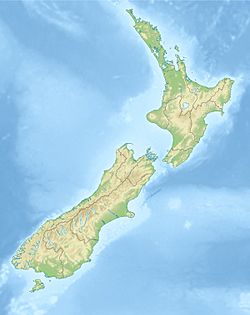2003 Fiordland earthquake facts for kids
| UTC time | 2003-08-21 12:12:49 |
|---|---|
| ISC event | 7066570 |
| USGS-ANSS | ComCat |
| Local date | 22 August 2003 |
| Local time | 12:12 AM |
| Magnitude | 7.1 Mw |
| Depth | 12 km |
| Epicenter | 45°12′S 166°42′E / 45.2°S 166.7°E |
| Areas affected | New Zealand, South Island |
| Casualties | None |
An earthquake is when the ground shakes because of sudden movement deep inside the Earth. The 2003 Fiordland earthquake was a strong earthquake that hit a quiet part of Fiordland in the South Island of New Zealand. It happened very early in the morning on August 22, 2003, at 12:12 AM.
The earthquake's starting point, called the epicentre, was about 12 kilometres (7.5 miles) deep. It was thought to be near Secretary Island, close to the entrance of Doubtful Sound. This was the same spot where a similar earthquake happened ten years earlier, in 1993.
What Happened During the Quake?
This earthquake was very powerful, measuring 7.1 on the moment magnitude scale. It was one of the biggest shallow earthquakes in New Zealand since 1968. A shallow earthquake means it started close to the Earth's surface.
About two hours after the main quake, there was a large aftershock. Aftershocks are smaller earthquakes that happen after a big one. Over the next few days and weeks, many more small tremors followed. By September 21, 2003, there had been 6,365 aftershocks!
Why Do Earthquakes Happen in Fiordland?
Fiordland is a very active place for earthquakes. This is because two of the Earth's giant plates, the Australian Plate and the Pacific Plate, are constantly pushing against each other there.
The Pacific Plate is slowly sliding underneath the Australian Plate. This movement causes a lot of stress in the rocks. Earthquakes are like a way for the Earth to release this built-up stress. In August 2004, another big earthquake, also 7.1 magnitude, happened in Fiordland.
What Was the Damage Like?
Even though the earthquake was very strong, luckily, no one was hurt. About 70 kilometres (43 miles) away, in a town called Te Anau, people felt the quake strongly.
Things fell off shelves in shops and homes. Some kids at Te Anau Primary School said they felt "weird" or "scared" during the shaking.
A team of scientists who study the Earth, called geologists, went to investigate the area. They saw many landslides, which are when large amounts of rock and soil slide down hills. They flew over most of central and western Fiordland and counted at least 200 landslides caused by the earthquake.



